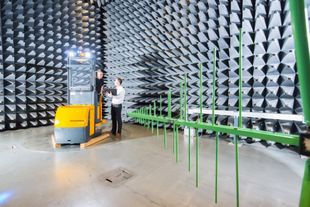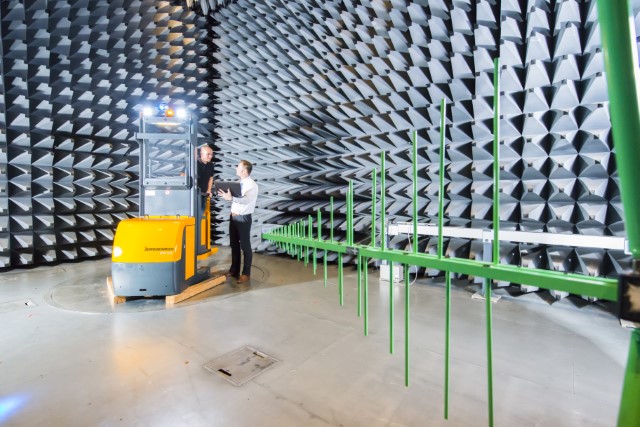Key role of electromagnetic compatibility
Electromagnetic compatibility (EMC) plays a key role in ensuring that electrical systems and devices not only function perfectly on their own, but also operate in harmony with each other.
In the Electromagnetic Compatibility Act (EMVG), the legislator has made compliance with basic EMC requirements mandatory on the basis of EU Directive 2014/30/EU. For manufacturers, successful EMC tests in accordance with this directive also represent a key quality feature of their products, as this prevents product or system failures due to electromagnetic interference.




EMC and High Frequency Technology
TÜV NORD specializes in testing electrical and electronic devices in the areas of radio, EMC and electrical safety. We advise you on which regulations and standards apply to your device and take over the complete processing of the services you require. In this way, you ensure legally compliant market access. Worldwide, we are at your side for the testing and international certification of devices that use radio modules or radio services. This includes, for example, applications ranging from RFID, BT and WLAN to radar applications at frequencies of 24 GHz, 77 GHz or higher. Yet, of course, we also test electronic devices without radio modules in the areas of EMC and electrical safety.
Do you have a question?
Do you want to have an offer?
Electromagnetic Compatibility – EU Directive 2014/30/EU
The EMC Directive 2014/30/EU applies to the placing on the market or making available of equipment, i.e. apparatus and fixed installations in the European Economic Area. The EMC Directive lays down basic requirements for electromagnetic compatibility for proper installation and maintenance as well as intended use. The scope of the directive includes all equipment that causes electromagnetic interference or whose operation may be affected by such interference.
For electrical and electronic products, CE marking is mandatory in the vast majority of cases.
The CE marking certifies conformity with the harmonized EU directives.
CE marking according to applicable EU regulations
A corresponding test, e.g. according to DIN EN 61010-1 or DIN EN 62368-1 (replacement for DIN EN 60065-1 and DIN EN 60950-1), by TÜV NORD serves as the basis for a CE marking of the respective device. The test also takes into account electrical, thermal and mechanical hazards, e.g. by means of insulation measurements, high-voltage tests, heating tests, short-circuit tests, impact and drop tests and determination of clearances and creepage distances. For this purpose, in addition to the device to be tested, its operating instructions, circuit diagrams, parts lists, material data and - depending on the product - other relevant documents must be made available and assessed.
Frequently asked questions about EMC testing - We have the answers (FAQ)
As a manufacturer, when do I have to carry out an EMC test?
An electrical or electronic product is usually covered by the EMC Directive. The European EMC Directive (2014/30/EU) defines products and the procedure for this. If your product falls within the scope of the Directive, you are obliged to prove the conformity of your product with technical documentation. A technical report based on a test is a very good form of evidence and has proven itself in practice.
What does an EMC test cost?
This varies greatly. The costs depend strongly on the subsequent area of use or the application of the device. This results in the applicable standards, the requirements of which differ greatly. In addition, there are the type and number of external interfaces, the dimensions of the device as well as individual parameters of your device such as internal process sequences and clock frequencies.
For this reason, you will receive a calculated offer from us for every enquiry, which transparently discloses the costs to be expected. The quickest way to receive your offer is to fill out the offer questionnaire and send it to us.
How long does the EMC test take?
An EMC test usually takes 2-3 days. For complex systems or certain standards, however, it can also be 5-10 days. We will give you an individual estimate for each enquiry. The lead time for a test date is usually about 3-4 weeks. If you are pressed for time, please contact us. We will then try to accommodate your request for an appointment.
Can I be present at the tests?
Yes, you can accompany the tests. Especially during the commissioning of your product, errors can be excluded in this way. In the Corona pandemic, the legal access regulations for workplaces apply. But even without you being on site, our well-trained technicians and engineers will be happy to carry out the test as per your instructions.
How does the EMC test work? What is tested?
Basically, all electromagnetic effects that are realistic for a device are examined in different individual tests. A fundamental distinction is made between the interference emissions of a device and the requirements for the interference immunity of a device. Interference emissions are the electromagnetic waves emitted by your device that could possibly influence other devices or the various radio services in their function. Defined limits must therefore be observed in these tests.
In the case of interference immunity, physical effects from the environment are simulated and the extent to which the device itself is affected is checked. These are, for example, electrostatic discharges (ESD) on connection points and displays, voltage fluctuations and power grid failures in the power supply line. But also switching operations (bursts), lightning couplings (surges) and induced interference voltages from HF sources such as mobile phones.
Do you also perform on-site tests?
Yes, this can be useful for larger devices. Typically, EMC tests are also carried out on site for railway applications, but also for larger industrial devices in manufacturing or production technology. However, there are still a few things to consider. We would be happy to discuss this with you in detail.
What do I need to prepare for the EMC test?
The best preparation for EMC testing is a test plan. This is not about writing off the standard on which the test is based. Rather, it is about the following points: How will the device be operated in the laboratory? What connected loads and cable lengths are required? What peripherals are needed? Is compressed air or liquid cooling required? Which operating states have to be taken into account (e.g. charging mode, normal mode, stand-by)?
Which software version is used for the test? What criteria apply to the immunity tests? Which error limits apply to which parameters (e.g. sensor 1, temperature ± 0.5 °C)? How can these parameters be monitored?
We will support you in this, please do not hesitate to contact us.
Does the laboratory issue the CE declaration or certificate?
The manufacturer himself issues the CE declaration of conformity. This CE declaration takes into account all applicable regulations that apply to the product. A certificate for EMC is usually not necessary.
Is an EMC test already useful in the development phase?
Early, development-accompanying testing can help you meet deadlines and budgets. This is especially true for completely new developments. We support you with our measurement tools during the analysis so that the requirements are met. By identifying possible weak points at an early stage, they can be taken into account, for example, in the context of a function-related redesign or series production - without the need for an extra round shortly before delivery.
What happens if my product fails the tests?
With our experience and extensive equipment, we support you in identifying the weak point. A small workshop and various EMC components are of course available to you for conversions and optimizations.
My product has a Bluetooth module. Is that relevant?
Devices with permanently integrated radio modules generally fall within the RED (Radio Equipment Directive). If radio modules are used, a CE declaration of conformity according to 2014/53/EU (RED) is required. Furthermore, additional tests are carried out to ensure that the radio modules function as intended in combination with the device.
What does EMC actually mean?
EMC is the electromagnetic compatibility of electrical devices with each other. The aim is to ensure that the product to be tested does not interfere with other devices in the intended environment and that radio services such as mobile radio or TETRA (radio of the emergency services) remain usable without restriction.
On the other hand, the product to be tested should have a resistance to expected interference such as electrostatic discharges (e.g. lift control).
The exact requirements result from the intended use and the place of use of the device and are defined in directives, standards, norms, regulations and ordinances.





